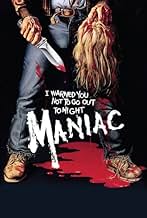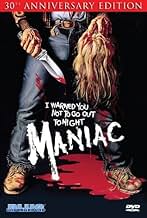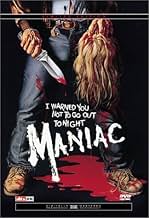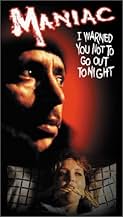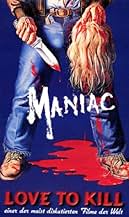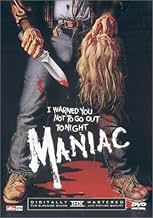A psychopathic man goes on a killing and mutilation spree in New York City.A psychopathic man goes on a killing and mutilation spree in New York City.A psychopathic man goes on a killing and mutilation spree in New York City.
- Awards
- 1 nomination
Abigail Clayton
- Rita
- (as Gail Lawrence)
James L. Brewster
- Beach Boy
- (as James Brewster)
Frank Pesce
- T.V. Reporter
- (voice)
Storyline
Did you know
- TriviaWilliam Lustig and Joe Spinell say they didn't always have the necessary permits to film on location in New York City. Certain scenes (including the infamous shotgun through the windshield scene) had to have been filmed quickly and afterwards the crew had to run away before the cops arrived.
- GoofsThe nurse is supposedly alone in the subway station, but during one shot (from inside the subway train as it pulls away) we can see several people walking about on the platform; they all disappear in the next shot.
- Quotes
Frank Zito: I told you not to go out tonight, didn't I? Every time you go out, this kind of thing happens.
- Alternate versionsThe film was rejected for a cinema certificate in 1981 by the BBFC and also for a video rating in 1998. It was finally released in the UK on the Anchor Bay label in 2002 after receiving 58 secs of cuts to a prolonged strangulation scene and to a sexualized stabbing sequence.
- ConnectionsEdited from Inferno (1980)
Featured review
Over one century ago (1897 to be exact) in the dingy back streets of Montmartre, Paris, an eccentric ex-secretary to a Police commissioner named Oscar Metenier, opened the Theatre du Grand Guignol. For 65 years, groups of performers staged one-act plays that depicted graphic scenes of murder, mutilation and torture. Famous works by authors such as Charles Dickens and James Hadley Chase were adapted for Grand Guignol and made into, some might say, horrific gore-laden masterpieces. People's morbid curiosities kept the shows ever popular, all the way up until the Nazis invaded France during World War II. Perhaps because the French population was experiencing true horrors of their own, the urge to see such events portrayed on stage, quite obviously became a lot less alluring. The theatre never recovered, and it finally closed its doors for the last time in 1962. William Lustig's Maniac is basically Grand Guignol for the cinematic audiences of the eighties. A movie that viewers of a quainter disposition will describe as depraved, demoralising and redundantly mean spirited, while others have touted its story telling as artistic, ballsy and daring. Although its often labelled as a formulaic stalk and slash offering, it is actually a member of the sub, sub-genre that differentiates itself from the Halloween and Friday the 13th created format. Along with Nightmares in a Damaged Brain, Mardi Gras Massacre, and Don't go in the House; Maniac offers something refreshing, by giving the killer characterisation and making him more than just a loony in a mask with a machete.
The plot portrays the life of Frank Zito, an insane and stammering psychological mess of a man, with more than a few severe problems upstairs. His story unravels around his decent into madness, which stems from his seclusion and isolation from the outside world. He is a lonely, redoubtable character, with no friends or companionship; he's just alone with his fragmented mind to torment him. His desperation to feel accepted by civilisation results in him creating his own 'family' from female mannequins. To add realism to their beings and to make them as human-like as could be possible, he furnishes their heads with the scalps of women that he butchers remorselessly. In the first ten minutes, an unfortunate prostitute is ruthlessly slaughtered for no apparent reason, and the misogyny continues all the way through the movie; as nurses, models and innocent bystanders are gorily slain for nothing more than the misfortune of being in the wrong place at the wrong time. The creepiest thing about these murders, is the fact that Zito has no apparent understanding of the results of his actions. He reads headlines, which describe the feelings of a city left in fear by his spate of madness and he watches news updates that inform us of the aftermath of his bloodthirsty rein. But his reaction is non-existent; he shows no knowledge of any wrongdoing, almost like he is unaware that he commits such atrocities. His mental downfall takes a U-turn, when he meets up with Anna D'Antoni (Caroline Munro) a photographer that attracts his attention for the first time when she snaps him wondering through a park. We finally get to see a thoroughly different side to his character, - a romantic, insecure personality that's been buried beneath years of self-inflicted misery and emotional torture. There is a constant battle between two separate personalities that rages inside Zito's mind however, and Anna's fate depends upon whether the good or evil side emerges victoriously...
The opening sequence stays true to its stalk and slash counterparts; as the masked, heavy breathing Zito kills a loving couple on a beach. Lustig describes the scene as a homage to Jaws, only this time the monster is out of the sea and on land, thus explaining the beach setting. It's a well-handled commencement, with Savini adding the magic that he is most reputed for; and Robert Lindsay's competent photography creates energy that prevails throughout the whole movie. Although body count material is introduced without any characterisation or development, it can be argued that the story resolves around Zito; and to him, victims are only objects or playthings anyway. I have always considered Bill Lustig to be a highly underrated filmmaker. Maniac Cop was yet another great movie, although I would consider this to be one of his best - probably because he was relatively unknown when he worked it. The parts that were filmed inside the killer's flat are shot in complete silence, which effectively adds to the feeling of seclusion and abandonment. It's like the viewer is inside the character's apartment, but also inside his own remote world, where his loneliness has degenerated into an unrelenting insanity. It's added moments like these that make Maniac all the more creepy. The subway scene adds some awe-inspiring suspense, as Frank stalks a nurse through the station. Lustig does well to keep the atmosphere tense and the viewer is always aware that something is about to happen, meaning there is never any allowance for comfort in the fact that any of the characters will escape to safety. He also manages at least two effective jump-scares, the final Carrie-esque jolt being particularly memorable. Jay Chattaway provides a superb score to accompany the visuals, and Lorenzo Marinelli's editing is equally impressive.
Although you could never call Joe Spinnell a fantastic dramatic performer by any of his pre-Maniac work, Frank Zito (named as a nod to Joseph Zito the director of The Prowler and friend to Lustig and Savini) was undoubtedly the part he was put on this planet to play. It's a convincing performance that allowed the actor to immerse himself deep into something that he had researched thoroughly and accurately, giving his character a vivid portrait of realism that was necessary to create the child's nightmare-like quality that the movie possesses. Spinnell is Maniac and Maniac is Spinnell, there's no doubt about it; it was his signature role. It's impossible to imagine another character actor fitting the bill so perfectly. Not only does he play the part; he also looks and sounds it too. He wasn't the only one that hit a career high under Lustig's direction though; the ever-adorable Caroline Munro gave her most realistic portrayal too. Her star had just reached its zenith in 1980, before she became a scream queen in less memorable flicks such as Slaughter High and Faceless, which would supplement her income, well into motherhood. This also offered a chance to break away from the bikini-clad bimbo roles that she had been given up until that point; and it gave her the chance to try something a little different. I strongly respect her refusal to do any nudity, which cost a further contract with Hammer in the early seventies. It takes a strong women to reject such offers for the sake of her modesty, and Munro proved that she was just that; and her career strengthened because of it. It's worth noting that the pair were reunited two years later for Fanatic (aka The Last Horror Film), which lacked the gritty edge and invitingly sleazy surroundings of its predecessor, but attempted to cash-in on the fame that Lustig's film had earned from its gruesome reputation.
Maniac was filmed on super 16 mm and like the best slashers from this period, it was shot for the most miniscule of budgets ('under a million dollars'). A lot of the on-location work was staged illegally, without any insurance or authorised permission. Lustig anecdotes about the exploding head scene (no less than Tom Savini's, by the way), where they had to fire a shotgun through the windscreen of a car and then make a quick getaway, before the Police arrived to investigate the gunshot! Munro was given only one-day to rehearse the script before starting work, due to replacing Dario Argento's wife of the time, Daria Nicolodi. Admittedly, it does seem pretty strange that a woman with a name as Italian as Anna D' Antoni, would be played by an English Rose; but she does a good enough job and is truly a sight to behold. Many, MANY countries rejected this movie on the grounds of its unnecessary violence towards women; including the censors here in the UK, who made sure to add it to the DPP list almost immediately. The Philippines' board of film review was so outraged by what they discovered that they told the producers to take it to Satan instead of their country, and went on to describe it as 'unentertaining' and 'unfit for Human consumption'! Of course, knowledge of those monstrosities, only made it seem all the more curious to youngsters that had heard such tales of unruly degradation, and were eager to check it out for themselves; thus earning it a massive cult following. Upon release, it became immensely popular, although it was heavily criticised for its brutal violence. Spinnell said that the blood was never on screen long enough for his creation to be considered too gruesome. He lied; - there are parts of the movie that are limitlessly gory and blood-soaked. You'll find decapitations scalpings and dismemberment, - if you can name a gory way to slaughter a female, then you'll find it somewhere in here. Maniac is one of the only video-nasties that have managed to retain its shock factor, even after twenty-four years!
I saw an edited copy of this in the mid-nineties and was unimpressed. Perhaps my attentions were elsewhere or I was expecting something more? I can't be sure, but last night, watching it once again for this review, I found myself captivated. There are flaws, yes for certain. It's unlikely that a beauty as striking, as Anna would give the time of day to a misfit like Zito in the first place, and the end sequence is a little bizarre to say the least. But all niggles are forgiven when you acknowledge the effort that has been put into making this production as realistically as they possibly could. Credit has to be given to Spinnell for believing in the project and his dedication and research into serial killers deserves recognition. I haven't yet seen Henry Portrait of a Serial Killer, although I'm told that the two movies have a great deal in common, so I'm after a copy right now. Maniac has earned itself another fan, and I believe that it deserves to be seen. There has never been, and probably never will be, another movie so depraved and disturbing; so grab a copy whilst you've got the chance. It's an innovative and daring take on the standard slasher genre, which succeeds because it is just that.
The plot portrays the life of Frank Zito, an insane and stammering psychological mess of a man, with more than a few severe problems upstairs. His story unravels around his decent into madness, which stems from his seclusion and isolation from the outside world. He is a lonely, redoubtable character, with no friends or companionship; he's just alone with his fragmented mind to torment him. His desperation to feel accepted by civilisation results in him creating his own 'family' from female mannequins. To add realism to their beings and to make them as human-like as could be possible, he furnishes their heads with the scalps of women that he butchers remorselessly. In the first ten minutes, an unfortunate prostitute is ruthlessly slaughtered for no apparent reason, and the misogyny continues all the way through the movie; as nurses, models and innocent bystanders are gorily slain for nothing more than the misfortune of being in the wrong place at the wrong time. The creepiest thing about these murders, is the fact that Zito has no apparent understanding of the results of his actions. He reads headlines, which describe the feelings of a city left in fear by his spate of madness and he watches news updates that inform us of the aftermath of his bloodthirsty rein. But his reaction is non-existent; he shows no knowledge of any wrongdoing, almost like he is unaware that he commits such atrocities. His mental downfall takes a U-turn, when he meets up with Anna D'Antoni (Caroline Munro) a photographer that attracts his attention for the first time when she snaps him wondering through a park. We finally get to see a thoroughly different side to his character, - a romantic, insecure personality that's been buried beneath years of self-inflicted misery and emotional torture. There is a constant battle between two separate personalities that rages inside Zito's mind however, and Anna's fate depends upon whether the good or evil side emerges victoriously...
The opening sequence stays true to its stalk and slash counterparts; as the masked, heavy breathing Zito kills a loving couple on a beach. Lustig describes the scene as a homage to Jaws, only this time the monster is out of the sea and on land, thus explaining the beach setting. It's a well-handled commencement, with Savini adding the magic that he is most reputed for; and Robert Lindsay's competent photography creates energy that prevails throughout the whole movie. Although body count material is introduced without any characterisation or development, it can be argued that the story resolves around Zito; and to him, victims are only objects or playthings anyway. I have always considered Bill Lustig to be a highly underrated filmmaker. Maniac Cop was yet another great movie, although I would consider this to be one of his best - probably because he was relatively unknown when he worked it. The parts that were filmed inside the killer's flat are shot in complete silence, which effectively adds to the feeling of seclusion and abandonment. It's like the viewer is inside the character's apartment, but also inside his own remote world, where his loneliness has degenerated into an unrelenting insanity. It's added moments like these that make Maniac all the more creepy. The subway scene adds some awe-inspiring suspense, as Frank stalks a nurse through the station. Lustig does well to keep the atmosphere tense and the viewer is always aware that something is about to happen, meaning there is never any allowance for comfort in the fact that any of the characters will escape to safety. He also manages at least two effective jump-scares, the final Carrie-esque jolt being particularly memorable. Jay Chattaway provides a superb score to accompany the visuals, and Lorenzo Marinelli's editing is equally impressive.
Although you could never call Joe Spinnell a fantastic dramatic performer by any of his pre-Maniac work, Frank Zito (named as a nod to Joseph Zito the director of The Prowler and friend to Lustig and Savini) was undoubtedly the part he was put on this planet to play. It's a convincing performance that allowed the actor to immerse himself deep into something that he had researched thoroughly and accurately, giving his character a vivid portrait of realism that was necessary to create the child's nightmare-like quality that the movie possesses. Spinnell is Maniac and Maniac is Spinnell, there's no doubt about it; it was his signature role. It's impossible to imagine another character actor fitting the bill so perfectly. Not only does he play the part; he also looks and sounds it too. He wasn't the only one that hit a career high under Lustig's direction though; the ever-adorable Caroline Munro gave her most realistic portrayal too. Her star had just reached its zenith in 1980, before she became a scream queen in less memorable flicks such as Slaughter High and Faceless, which would supplement her income, well into motherhood. This also offered a chance to break away from the bikini-clad bimbo roles that she had been given up until that point; and it gave her the chance to try something a little different. I strongly respect her refusal to do any nudity, which cost a further contract with Hammer in the early seventies. It takes a strong women to reject such offers for the sake of her modesty, and Munro proved that she was just that; and her career strengthened because of it. It's worth noting that the pair were reunited two years later for Fanatic (aka The Last Horror Film), which lacked the gritty edge and invitingly sleazy surroundings of its predecessor, but attempted to cash-in on the fame that Lustig's film had earned from its gruesome reputation.
Maniac was filmed on super 16 mm and like the best slashers from this period, it was shot for the most miniscule of budgets ('under a million dollars'). A lot of the on-location work was staged illegally, without any insurance or authorised permission. Lustig anecdotes about the exploding head scene (no less than Tom Savini's, by the way), where they had to fire a shotgun through the windscreen of a car and then make a quick getaway, before the Police arrived to investigate the gunshot! Munro was given only one-day to rehearse the script before starting work, due to replacing Dario Argento's wife of the time, Daria Nicolodi. Admittedly, it does seem pretty strange that a woman with a name as Italian as Anna D' Antoni, would be played by an English Rose; but she does a good enough job and is truly a sight to behold. Many, MANY countries rejected this movie on the grounds of its unnecessary violence towards women; including the censors here in the UK, who made sure to add it to the DPP list almost immediately. The Philippines' board of film review was so outraged by what they discovered that they told the producers to take it to Satan instead of their country, and went on to describe it as 'unentertaining' and 'unfit for Human consumption'! Of course, knowledge of those monstrosities, only made it seem all the more curious to youngsters that had heard such tales of unruly degradation, and were eager to check it out for themselves; thus earning it a massive cult following. Upon release, it became immensely popular, although it was heavily criticised for its brutal violence. Spinnell said that the blood was never on screen long enough for his creation to be considered too gruesome. He lied; - there are parts of the movie that are limitlessly gory and blood-soaked. You'll find decapitations scalpings and dismemberment, - if you can name a gory way to slaughter a female, then you'll find it somewhere in here. Maniac is one of the only video-nasties that have managed to retain its shock factor, even after twenty-four years!
I saw an edited copy of this in the mid-nineties and was unimpressed. Perhaps my attentions were elsewhere or I was expecting something more? I can't be sure, but last night, watching it once again for this review, I found myself captivated. There are flaws, yes for certain. It's unlikely that a beauty as striking, as Anna would give the time of day to a misfit like Zito in the first place, and the end sequence is a little bizarre to say the least. But all niggles are forgiven when you acknowledge the effort that has been put into making this production as realistically as they possibly could. Credit has to be given to Spinnell for believing in the project and his dedication and research into serial killers deserves recognition. I haven't yet seen Henry Portrait of a Serial Killer, although I'm told that the two movies have a great deal in common, so I'm after a copy right now. Maniac has earned itself another fan, and I believe that it deserves to be seen. There has never been, and probably never will be, another movie so depraved and disturbing; so grab a copy whilst you've got the chance. It's an innovative and daring take on the standard slasher genre, which succeeds because it is just that.
- RareSlashersReviewed
- Apr 7, 2004
- Permalink
Details
- Release date
- Country of origin
- Language
- Also known as
- 瘋狂殺手
- Filming locations
- Hotel St. James, 109 West 45th St, Manhattan, New York City, New York, USA(the hotel where Frank kills the prostitute)
- Production company
- See more company credits at IMDbPro
Box office
- Budget
- $350,000 (estimated)
- Runtime1 hour 27 minutes
- Color
- Sound mix
- Aspect ratio
- 1.85 : 1
Contribute to this page
Suggest an edit or add missing content




